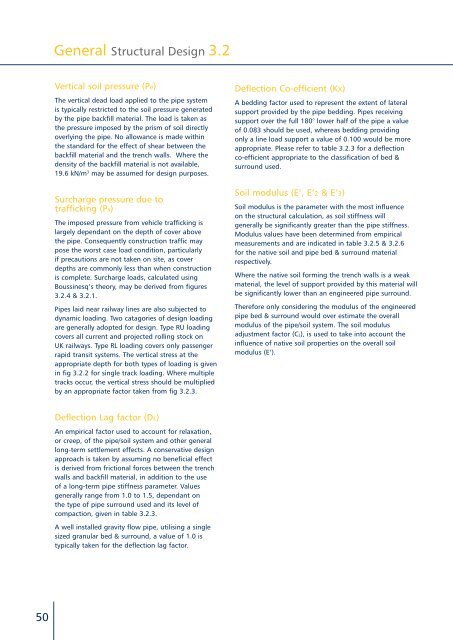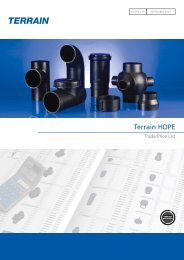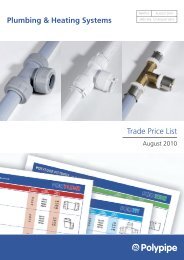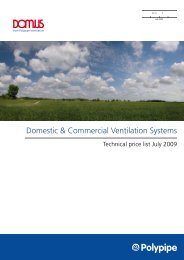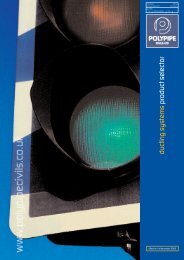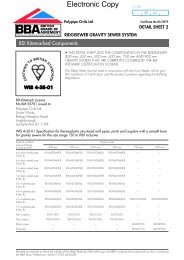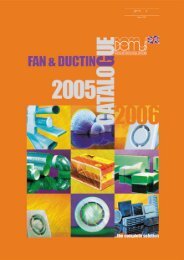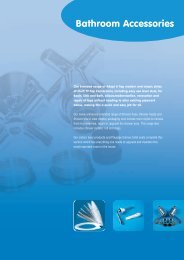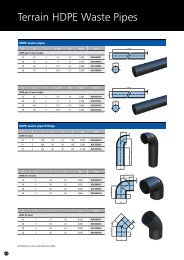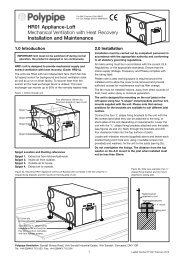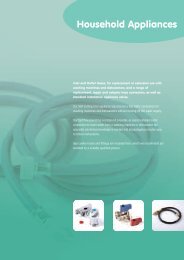advanced drainage system - Polypipe
advanced drainage system - Polypipe
advanced drainage system - Polypipe
Create successful ePaper yourself
Turn your PDF publications into a flip-book with our unique Google optimized e-Paper software.
General Structural Design 3.2<br />
Vertical soil pressure (Pe)<br />
The vertical dead load applied to the pipe <strong>system</strong><br />
is typically restricted to the soil pressure generated<br />
by the pipe backfill material. The load is taken as<br />
the pressure imposed by the prism of soil directly<br />
overlying the pipe. No allowance is made within<br />
the standard for the effect of shear between the<br />
backfill material and the trench walls. Where the<br />
density of the backfill material is not available,<br />
19.6 kN/m 3 may be assumed for design purposes.<br />
Surcharge pressure due to<br />
trafficking (Ps)<br />
The imposed pressure from vehicle trafficking is<br />
largely dependant on the depth of cover above<br />
the pipe. Consequently construction traffic may<br />
pose the worst case load condition, particularly<br />
if precautions are not taken on site, as cover<br />
depths are commonly less than when construction<br />
is complete. Surcharge loads, calculated using<br />
Boussinesq’s theory, may be derived from figures<br />
3.2.4 & 3.2.1.<br />
Pipes laid near railway lines are also subjected to<br />
dynamic loading. Two catagories of design loading<br />
are generally adopted for design. Type RU loading<br />
covers all current and projected rolling stock on<br />
UK railways. Type RL loading covers only passenger<br />
rapid transit <strong>system</strong>s. The vertical stress at the<br />
appropriate depth for both types of loading is given<br />
in fig 3.2.2 for single track loading. Where multiple<br />
tracks occur, the vertical stress should be multiplied<br />
by an appropriate factor taken from fig 3.2.3.<br />
Deflection Co-efficient (KX)<br />
A bedding factor used to represent the extent of lateral<br />
support provided by the pipe bedding. Pipes receiving<br />
support over the full 180° lower half of the pipe a value<br />
of 0.083 should be used, whereas bedding providing<br />
only a line load support a value of 0.100 would be more<br />
appropriate. Please refer to table 3.2.3 for a deflection<br />
co-efficient appropriate to the classification of bed &<br />
surround used.<br />
Soil modulus (E’, E’2 & E’3)<br />
Soil modulus is the parameter with the most influence<br />
on the structural calculation, as soil stiffness will<br />
generally be significantly greater than the pipe stiffness.<br />
Modulus values have been determined from empirical<br />
measurements and are indicated in table 3.2.5 & 3.2.6<br />
for the native soil and pipe bed & surround material<br />
respectively.<br />
Where the native soil forming the trench walls is a weak<br />
material, the level of support provided by this material will<br />
be significantly lower than an engineered pipe surround.<br />
Therefore only considering the modulus of the engineered<br />
pipe bed & surround would over estimate the overall<br />
modulus of the pipe/soil <strong>system</strong>. The soil modulus<br />
adjustment factor (CL), is used to take into account the<br />
influence of native soil properties on the overall soil<br />
modulus (E’).<br />
Deflection Lag factor (DL)<br />
An empirical factor used to account for relaxation,<br />
or creep, of the pipe/soil <strong>system</strong> and other general<br />
long-term settlement effects. A conservative design<br />
approach is taken by assuming no beneficial effect<br />
is derived from frictional forces between the trench<br />
walls and backfill material, in addition to the use<br />
of a long-term pipe stiffness parameter. Values<br />
generally range from 1.0 to 1.5, dependant on<br />
the type of pipe surround used and its level of<br />
compaction, given in table 3.2.3.<br />
A well installed gravity flow pipe, utilising a single<br />
sized granular bed & surround, a value of 1.0 is<br />
typically taken for the deflection lag factor.<br />
50


